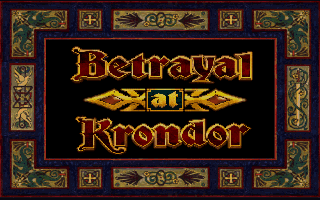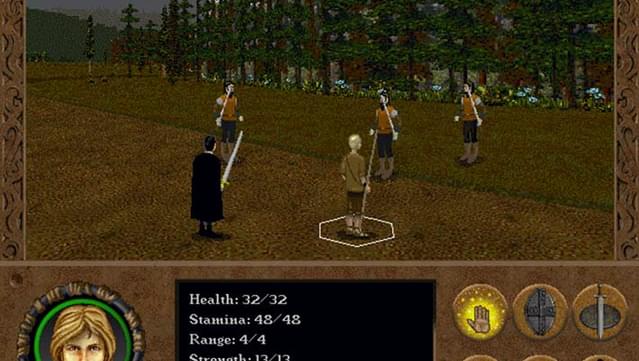

Only the images for inventory items, and the various menu screens in general, actually look good. The problem is especially bad for non-humanoid enemies like giant scorpions, which look like a muddy mess of brown pixels. Character images during conversations, or even the slightly smaller character portraits, are large enough to discern what the source image must have looked like, but the characters in the combat screens are too small to see clearly. It’s not just the basic, triangular landscapes and boxy buildings, it’s also the characters - the developers apparently took photographs of actors in (bad) costumes, then digitized them and displayed the pixellated, low-resolution images in the game. Early 3D games always look dated by today’s standards, but Betrayal at Krondor looks especially ugly.

Which brings up anther issue: the graphics. What was probably an attempt to keep the player from getting stopped dead all the time becomes an especial annoyance because the hills are nearly indistinguishable from the ground due to their bland, green grass coloring. Even worse, running into a hill or other obstacle does not simply stop the party’s movement, it turns the party to the side, so navigating a tight area means getting spun around and disoriented constantly. There are no stairs or ramps, and the smallest hill is an impassable obstacle. Also, the 3D world should probably be described as “ 2.5D“, since the party can only ever traverse a flat plane. This is uncomfortable, since the mouse is still used to interact with the world. Modern games have standardized this process, with the player’s left hand on the WASD keys for movement and the right hand on the mouse, but Betrayal at Krondor instead uses the arrow keys as movement shortcuts. Control is primarily mouse-based, with on-screen buttons for moving and turning, which is far more awkward than simply using the keyboard for movement. It was early days for 3D graphics, however, and the technical limitations led to some weaknesses.

This gives the game a pseudo-turn-based feel that strikes a nice balance between the strategic considerations of its forebears and the smooth response of games to follow. Also, like those games, time only advances when the party is moving. These steps are small enough that they simulate smooth movement in certain cases, especially when marching forward, but they are actually discrete in a manner similar to the older grid-based designs. It’s almost like an early first-person shooter, except movement is still step-based - in fact, the size of both the player party’s steps and the size of turning increments are adjustable from the in-game options menu. Technology had advanced enough to allow a (admittedly basic) three-dimensional world, and movement is significantly more sophisticated than in the early grid-based games. Where the early Might and Magic games used grid-based, step-by-step movement from a first-person perspective, and modern games like Skyrim keep the first-person perspective but add a fully three-dimensional world and smooth real-time movement, Betrayal at Krondor slots neatly between the two. The most noticeable way that Betrayal at Krondor differs from its predecessors, like Might and Magic, is in its technology. So playing Betrayal at Krondor, which was one of the first games to try it, has been fascinating. I was quite impressed with Skyrim’s achievement in this regard. Today’s games, like Skyrim, instead try to offer a believable place to explore, with a recognizable landscape and culture.
Betrayal at krondor 2 full#
Other role-playing games, like Might and Magic: Book One, gave the player a world to wander freely, but these were abstractions - Might and Magic’s tile-based world was a symbolic representation rather than a realistic one, full of random battles with strange beasts and a lot of other things that didn’t really make sense. Or at least, providing a world that feels like a real place populated by real people was. But in 1993, when Betrayal at Krondor was released, it was a more novel notion. This is certainly not an unfamiliar concept most recently, Skyrim embraced the same philosophy, and I’ve written about it at length.
Betrayal at krondor 2 free#
Other History Lessons posts can be found here.Īt the end of part 1, I was marveling at Betrayal at Krondor’s open world, which left me free to wander the length of the Kingdom instead of attending to my rather pressing business. Also be sure to read part 1 before continuing. New readers may wish to read my History Lessons Introduction first.


 0 kommentar(er)
0 kommentar(er)
